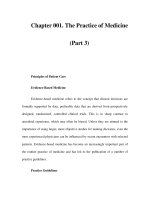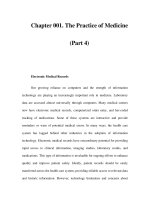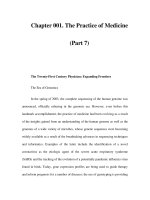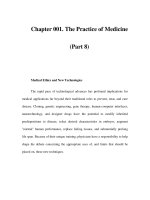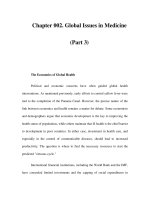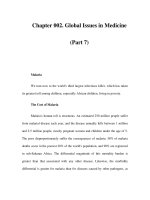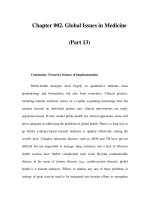Chapter 001. The Practice of Medicine (Part 3) ppt
Bạn đang xem bản rút gọn của tài liệu. Xem và tải ngay bản đầy đủ của tài liệu tại đây (13.61 KB, 5 trang )
Chapter 001. The Practice of Medicine
(Part 3)
Principles of Patient Care
Evidence-Based Medicine
Evidence-based medicine refers to the concept that clinical decisions are
formally supported by data, preferably data that are derived from prospectively
designed, randomized, controlled clinical trials. This is in sharp contrast to
anecdotal experience, which may often be biased. Unless they are attuned to the
importance of using larger, more objective studies for making decisions, even the
most experienced physicians can be influenced by recent encounters with selected
patients. Evidence-based medicine has become an increasingly important part of
the routine practice of medicine and has led to the publication of a number of
practice guidelines.
Practice Guidelines
Professional organizations and government agencies are developing formal
clinical-practice guidelines to aid physicians and other caregivers in making
diagnostic and therapeutic decisions that are evidence-based, cost-effective, and
most appropriate to a particular patient and clinical situation. As the evidence base
of medicine increases, guidelines can provide a useful framework for managing
patients with particular diagnoses or symptoms. They can protect patients—
particularly those with inadequate health care benefits—from receiving
substandard care. Guidelines can also protect conscientious caregivers from
inappropriate charges of malpractice and society from the excessive costs
associated with the overuse of medical resources. There are, however, caveats
associated with clinical practice guidelines since they tend to oversimplify the
complexities of medicine. Furthermore, groups with differing perspectives may
develop divergent recommendations regarding issues as basic as the need for
periodic sigmoidoscopy in middle-aged persons. Finally, guidelines do not—and
cannot be expected to—account for the uniqueness of each individual and his or
her illness. The physician's challenge is to integrate into clinical practice the useful
recommendations offered by experts without accepting them blindly or being
inappropriately constrained by them.
Medical Decision-Making
Medical decision-making is an important responsibility of the physician
and occurs at each stage of the diagnostic and treatment process. It involves the
ordering of additional tests, requests for consults, and decisions regarding
treatment and prognosis. This process requires an in-depth understanding of the
pathophysiology and natural history of disease. As described above, medical
decision-making should be evidence-based so that patients derive the full benefit
of the scientific knowledge available to physicians. Formulating a differential
diagnosis requires not only a broad knowledge base but also the ability to assess
the relative probabilities of various diseases. Application of the scientific method,
including hypothesis formation and data collection, is essential to the process of
accepting or rejecting a particular diagnosis. Analysis of the differential diagnosis
is an iterative process. As new information or test results are acquired, the group
of disease processes being considered can be contracted or expanded
appropriately.
Despite the importance of evidence-based medicine, much of medical
decision-making relies on good clinical judgment—a process that is difficult to
quantify or even to assess qualitatively. Physicians must use their knowledge and
experience as a basis for weighing known factors along with the inevitable
uncertainties and the need to use sound judgment; this is particularly important
when a relevant evidence base is not available.
Several quantitative tools may be invaluable in synthesizing the available
information, including diagnostic tests, Bayes' theorem, and multivariate statistical
models. Diagnostic tests serve to reduce uncertainty about a diagnosis or
prognosis in a particular individual and to help the physician decide how best to
manage that individual's condition.
The battery of diagnostic tests complements the history and the physical
examination. The accuracy of a given test is ascertained by determining its
sensitivity (true positive rate) and specificity (true negative rate) as well as the
predictive value of a positive and negative result. Bayes' theorem uses information
on a test's sensitivity and specificity, in conjunction with the pretest probability of
a diagnosis, to determine mathematically the posttest probability of the diagnosis.
More complex clinical problems can be approached with multivariate
statistical models, which generate highly accurate information even when multiple
factors are acting individually or together to affect disease risk, progression, or
response to treatment.
Studies comparing the performance of statistical models with that of expert
clinicians have documented equivalent accuracy, although the models tend to be
more consistent. Thus, multivariate statistical models may be particularly helpful
to less experienced clinicians. See Chap. 3 for a more thorough discussion of
decision-making in clinical medicine.



